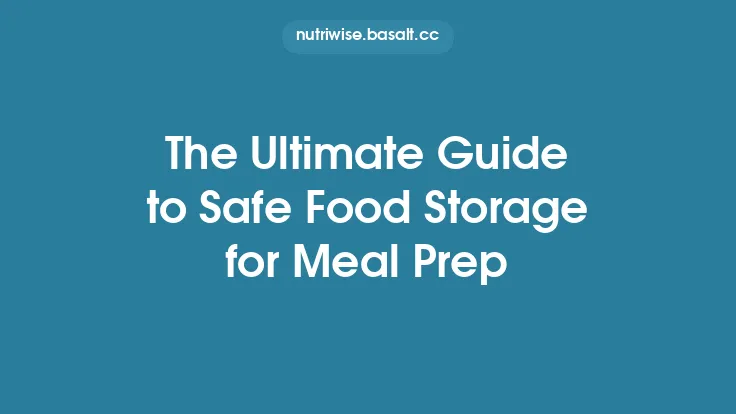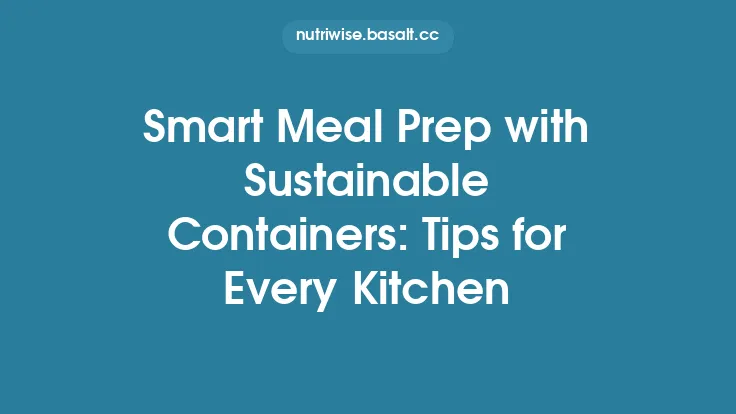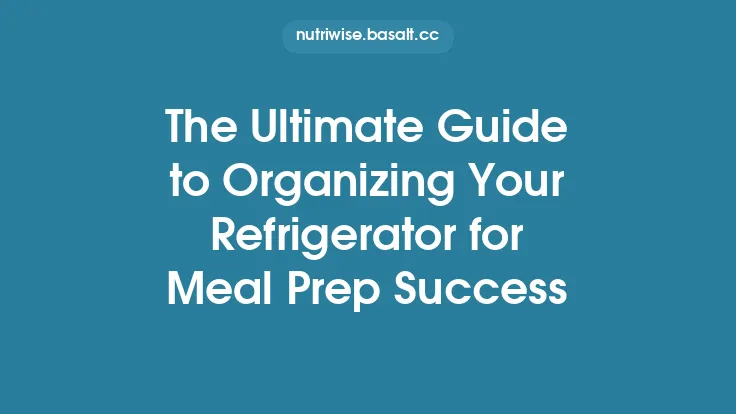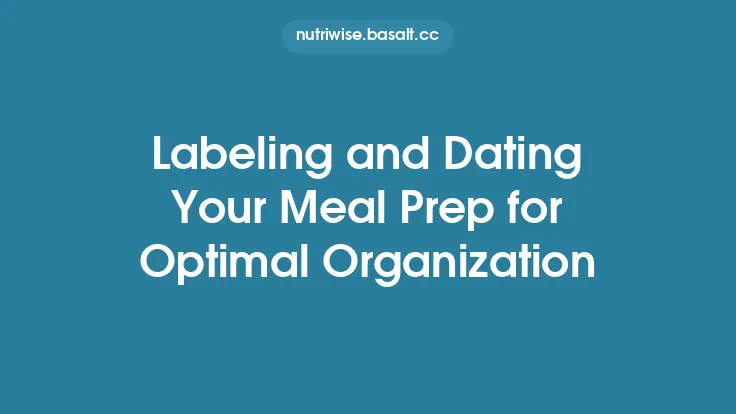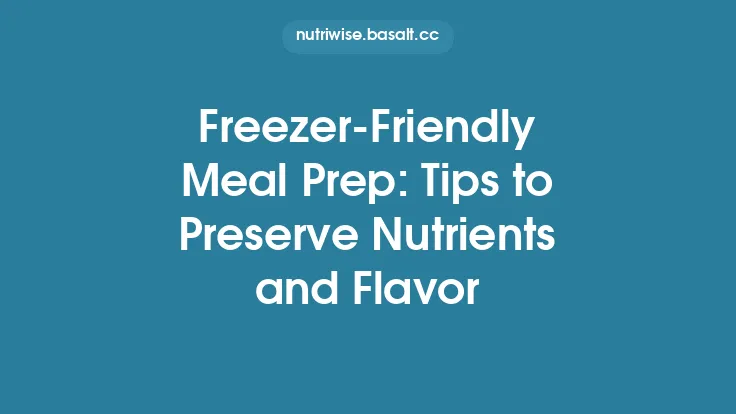When it comes to long‑term meal prep, the container you choose is just as important as the recipes you plan. A well‑chosen container protects flavor, preserves texture, and safeguards the nutritional integrity of your dishes over weeks or even months. Yet the market is flooded with options that differ in material, design, durability, and price, making the decision feel overwhelming. This guide walks you through the key factors to evaluate, helping you build a reliable, sustainable, and cost‑effective storage system that stands the test of time.
Understanding Container Materials
Glass
*Pros*: Non‑porous, inert, and free of chemicals that can migrate into food. Glass offers excellent clarity, making it easy to see contents at a glance. It tolerates a wide temperature range—from freezer to oven (typically up to 425 °F/220 °C).
*Cons*: Heavier than alternatives and prone to breakage if dropped. Some glass containers have plastic lids, so the lid material must be evaluated separately.
BPA‑Free Plastics
*Pros*: Lightweight, shatter‑resistant, and often come with snap‑fit or screw‑on lids that create a tight seal. Modern food‑grade plastics (polypropylene, high‑density polyethylene) are designed to withstand temperatures up to 212 °F (100 °C) for microwaving and down to –40 °F (–40 °C) for freezing.
*Cons*: Even BPA‑free plastics can leach other additives under extreme heat or prolonged storage. Look for containers labeled “microwave‑safe” and “freezer‑safe” and verify that they meet FDA food‑contact regulations.
Silicone
*Pros*: Flexible, virtually unbreakable, and capable of withstanding temperatures from –40 °F (–40 °C) to 500 °F (260 °C). Silicone seals are excellent for creating airtight closures without the need for additional gaskets.
*Cons*: Less rigid than glass or hard plastic, which can make stacking less stable. Some silicone containers have plastic lids that need separate assessment.
Stainless Steel
*Pros*: Extremely durable, resistant to corrosion, and free of chemicals that could leach into food. Stainless steel containers are ideal for transporting meals and can double as cooking vessels for stovetop or oven use (if the design permits).
*Cons*: Opaque, so you cannot see the contents without opening. Not microwave‑compatible, and lids are often made of plastic or silicone, requiring separate evaluation.
Hybrid Systems
Many manufacturers combine materials—glass jars with silicone seals, or stainless steel containers with BPA‑free plastic lids—to leverage the strengths of each. When evaluating hybrids, treat each component as an independent factor (material, seal, lid) and assess them against the criteria below.
Assessing Airtightness and Seal Quality
A truly airtight seal prevents oxidation, moisture loss, and the ingress of odors—all of which can degrade meals over time. Here’s how to gauge seal performance:
- Locking Mechanism – Screw‑on lids with a rubber or silicone gasket generally provide a more reliable seal than simple snap‑fit lids. Look for “locking” or “twist‑lock” designs that require a full turn to engage the gasket fully.
- Gasket Material – Food‑grade silicone gaskets are the gold standard. They remain flexible across temperature extremes and resist cracking. If the gasket is made of plastic, verify that it is labeled as “food‑grade” and “temperature‑resistant.”
- Pressure Test – Fill a container with water, close it tightly, and invert it. If no water leaks after a few minutes, the seal is effective. For a quick at‑home test, place a small amount of water in the container, seal it, and shake vigorously; any spillage indicates a weak seal.
- Ventilation Features – Some containers include a one‑way valve to release pressure when freezing. While useful for preventing lid blow‑outs, ensure the valve does not compromise long‑term airtightness once the container is returned to a stable temperature.
Temperature Tolerance: From Freezer to Microwave
Long‑term meal prep often involves moving containers between the freezer, refrigerator, and microwave. Selecting containers that can survive these temperature swings without warping, cracking, or leaching is essential.
| Material | Freezer Safe? | Microwave Safe? | Oven Safe? | Typical Temperature Range |
|---|---|---|---|---|
| Glass (tempered) | ✅ | ✅ (no metal lids) | ✅ (up to 425 °F) | –40 °F to 425 °F |
| BPA‑Free Plastic (PP, HDPE) | ✅ | ✅ (check label) | ❌ (usually) | –40 °F to 212 °F |
| Silicone | ✅ | ✅ | ✅ (up to 500 °F) | –40 °F to 500 °F |
| Stainless Steel | ✅ | ❌ | ✅ (if lid removed) | –40 °F to 500 °F (depends on finish) |
When a container is labeled “microwave‑safe,” it has passed tests for heat resistance and minimal chemical migration. However, repeated cycles of freezing and microwaving can stress the lid gasket; periodically inspect for cracks or loss of elasticity.
Durability and Longevity Considerations
A container that lasts years provides better value than a cheaper set that needs frequent replacement. Evaluate durability through the following lenses:
- Impact Resistance – Plastic and silicone excel here; glass is more fragile but can be tempered for added strength.
- Scratch Resistance – Scratches can harbor bacteria and degrade the appearance. Look for containers with a hard coating (e.g., Tritan® for plastics) that resists scratching.
- Chemical Resistance – Acidic foods (tomato sauce, citrus) can degrade certain plastics over time. Glass and stainless steel are immune to such reactions.
- UV Protection – If you store containers in a well‑lit pantry, UV‑blocking lids can prevent discoloration and nutrient loss in light‑sensitive foods.
Size, Shape, and Stackability for Efficient Storage
The geometry of your containers influences how many meals you can store in a given space and how easy it is to retrieve them.
- Modular Dimensions – Containers that follow a standard size (e.g., 4 × 4 × 2 inches) stack neatly and fit into most pantry shelves and freezer bins.
- Rectangular vs. Square – Rectangular containers maximize space in a typical refrigerator door or freezer drawer, while square containers are easier to stack in a cubical arrangement.
- Compartmentalized Designs – Some containers feature internal dividers, allowing you to keep proteins, carbs, and veggies separate without using multiple containers. Ensure the dividers are sealed and do not create dead zones where moisture can accumulate.
- Handle Placement – For larger containers, ergonomic handles reduce strain when lifting heavy, frozen meals. Handles should be positioned to keep the container’s center of gravity balanced.
Ergonomics and User Experience
Even the most technically perfect container will be underutilized if it’s cumbersome to open, close, or transport.
- One‑Hand Operation – Snap‑fit lids that can be opened with a thumb or a single finger are ideal for quick access.
- Clear Indicators – Some lids incorporate a visual cue (e.g., a colored ring) that changes when the seal is broken, providing an instant check of airtightness.
- Weight – A 1‑liter glass container typically weighs 1.2 lb, whereas a comparable plastic container may weigh 0.3 lb. Consider the cumulative weight if you transport multiple meals.
- Dishwasher Compatibility – Lids with silicone gaskets can sometimes warp in high‑heat dishwasher cycles. Look for “top‑rack safe” labeling if you plan to clean them this way.
Sustainability and Environmental Impact
Choosing containers with a low ecological footprint aligns long‑term meal prep with broader environmental goals.
- Recyclability – Glass and stainless steel are infinitely recyclable. Certain plastics (e.g., #5 polypropylene) are also widely accepted in recycling streams, but verify local guidelines.
- Life‑Cycle Assessment – While glass is heavier to ship, its durability often offsets the initial carbon cost. Silicone, derived from silica, has a moderate impact but offers a long service life.
- Reusable vs. Disposable – Investing in reusable containers eliminates the need for single‑use packaging, reducing waste. Some brands offer take‑back programs for end‑of‑life recycling.
- Material Sourcing – Look for containers made from post‑consumer recycled (PCR) plastics or stainless steel sourced from recycled scrap.
Cost vs. Value Analysis
Price alone does not dictate the best choice. Conduct a cost‑per‑use analysis:
- Initial Investment – A 12‑piece glass set may cost $80, while a comparable plastic set could be $40.
- Expected Lifespan – If the glass set lasts 10 years and the plastic set 3 years, the annualized cost for glass is $8, versus $13.33 for plastic.
- Replacement Frequency – Factor in the cost of lost lids or gaskets. Some manufacturers sell replacement seals for a fraction of the original set price.
- Hidden Savings – Durable containers reduce food waste by maintaining quality longer, indirectly saving money on groceries.
Maintenance, Cleaning, and Longevity
Proper care extends the life of your containers and maintains food safety.
- Hand vs. Dishwasher – While most containers are dishwasher‑safe, hand‑washing with a non‑abrasive sponge preserves silicone gaskets and prevents micro‑scratches on plastic.
- Stain Removal – For stubborn stains, a paste of baking soda and water applied for 15 minutes, followed by a gentle scrub, works well on glass and stainless steel. Avoid bleach on silicone as it can degrade the material.
- Drying – Allow lids and gaskets to air‑dry completely before resealing to prevent moisture buildup that can weaken the seal over time.
- Inspection Schedule – Every 6 months, examine lids for cracks, warping, or loss of elasticity. Replace compromised components promptly.
Choosing a System That Grows with Your Meal Prep Routine
Your container needs may evolve as you experiment with new recipes, batch sizes, or storage locations.
- Scalable Sets – Start with a core set of medium‑size containers (≈1 liter) and add larger or smaller units as needed. Many brands sell “mix‑and‑match” kits that maintain consistent lid designs across sizes.
- Interchangeable Lids – Some systems use universal lids that fit multiple container shapes, reducing the total number of parts you need to track.
- Specialty Add‑Ons – If you begin incorporating soups or sauces, consider adding a few heat‑proof glass jars with wide mouths for easy pouring.
- Future‑Proof Materials – Opt for containers made from materials that are unlikely to become obsolete due to regulatory changes (e.g., BPA‑free plastics that meet evolving safety standards).
Final Recommendations and Buying Checklist
To streamline your selection process, use the following checklist when evaluating potential containers:
- Material Suitability – Does the material meet your temperature‑range needs and chemical resistance requirements?
- Seal Integrity – Is there a silicone gasket? Does the lid lock securely?
- Size & Shape – Do the dimensions fit your storage space and portion sizes?
- Durability – Is the container impact‑resistant and scratch‑proof?
- Ergonomics – Are the lids easy to open/close? Are handles comfortable?
- Sustainability – Is the product recyclable or made from recycled content?
- Cost Efficiency – What is the projected cost per year of use?
- Maintenance – Is cleaning straightforward? Are replacement parts available?
- Compatibility – Can the container transition from freezer to microwave (if needed) without damage?
By systematically applying these criteria, you’ll assemble a container collection that safeguards your meals, respects your budget, and aligns with your lifestyle—ensuring that your long‑term meal prep remains efficient, enjoyable, and sustainable.
